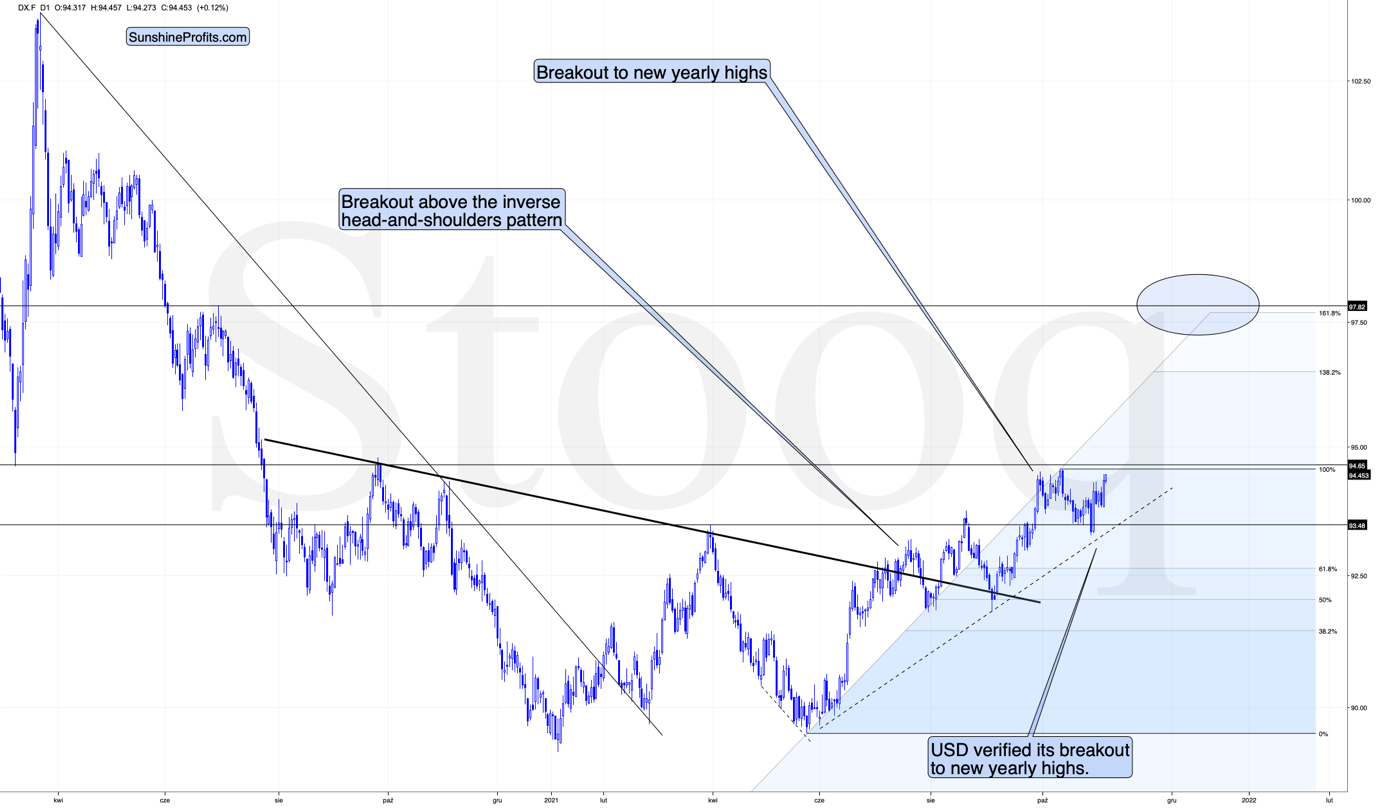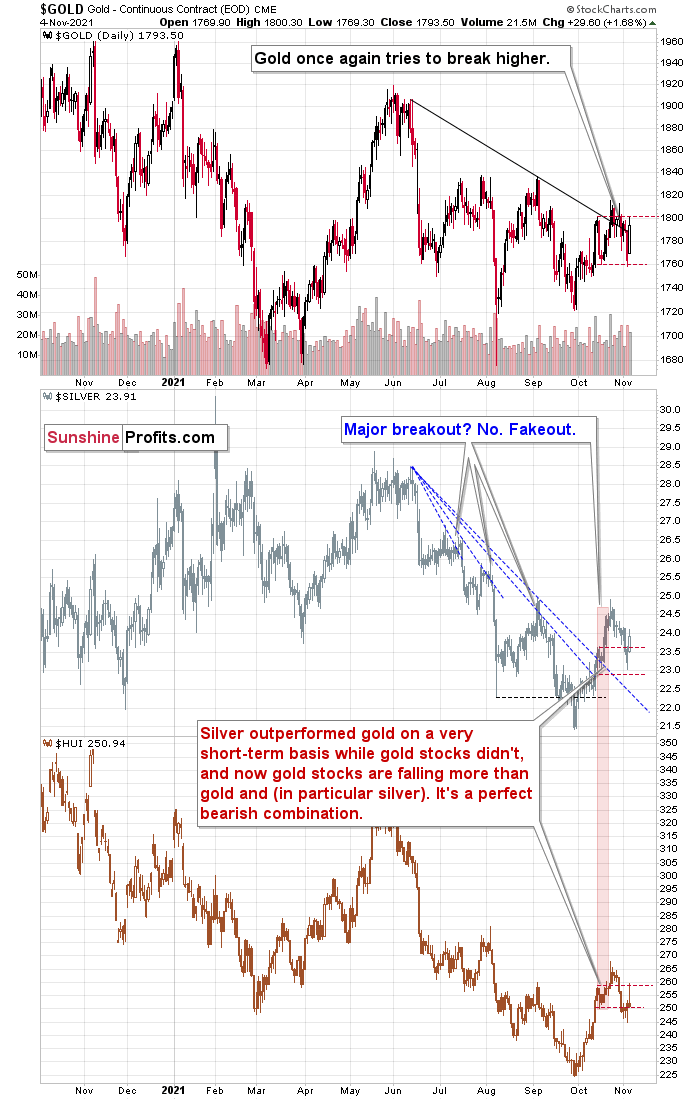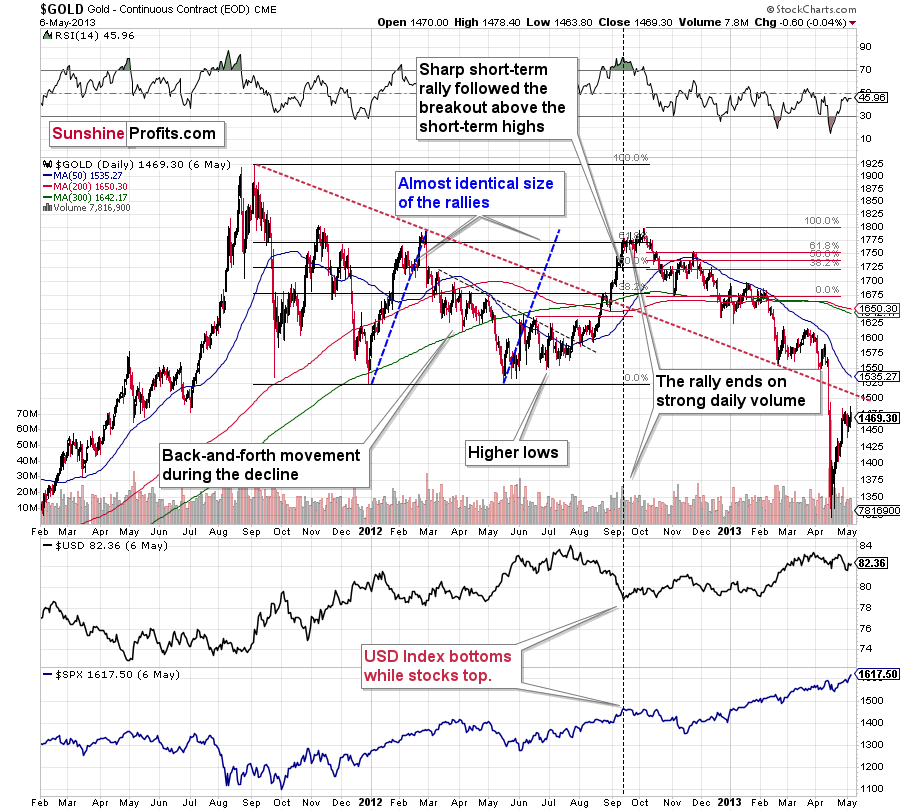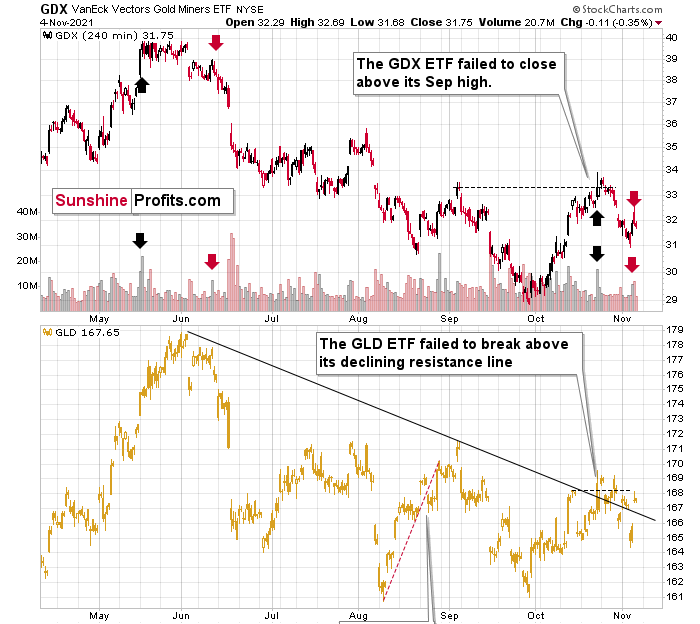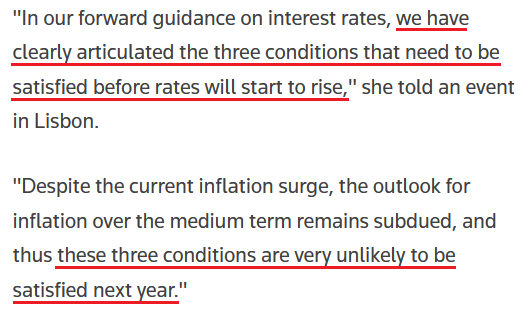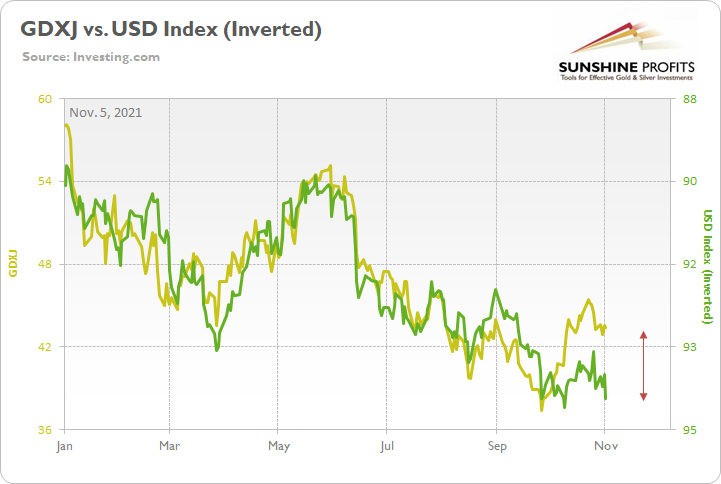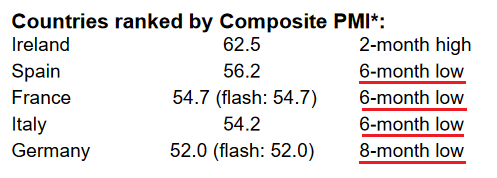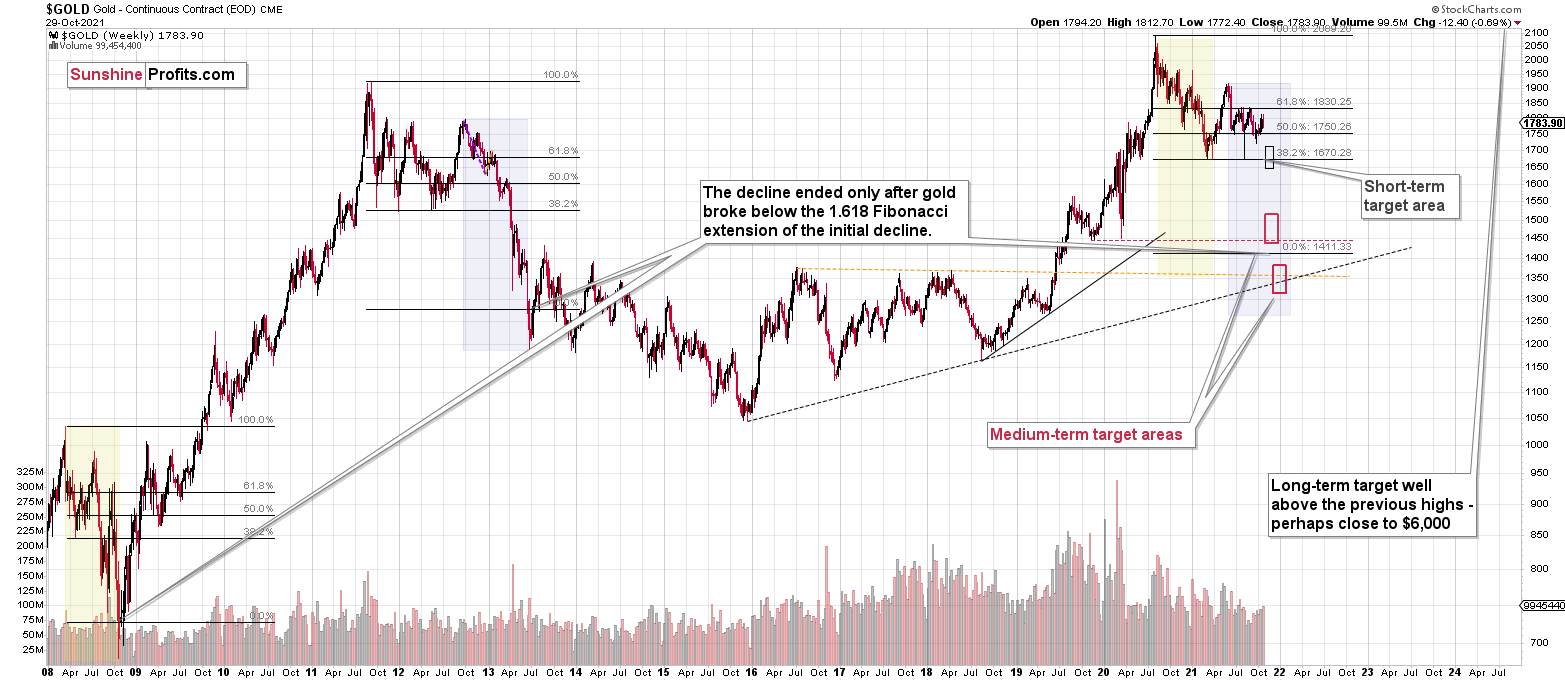Briefly: in our opinion, full (300% of the regular position size) speculative short positions in junior mining stocks are justified from the risk/reward point of view at the moment of publishing this Alert.
Lagarde spoke once again yesterday, and the markets reacted in a rather erratic manner once again too. The most important short-term details remain intact, though:
- The USD Index remains above its previous 2021 highs.
- Gold miners’ underperformance relative to gold is back with vengeance.
Let’s take a look at the charts.
The USD Index is once again moving higher, and once it breaks above its October highs, the volatility might be truly substantial. In fact, the USDX might then quickly shoot up to 97, just as it declined quickly from that level to the current levels in mid-2020.
The implications for the precious metals sector would be – of course – very bearish.
Yesterday, gold moved higher despite USD’s upswing, which might be viewed as bullish on regular days, but when there are comments regarding the euro on a given day, things are not that simple.
Gold was not that strong against the USD, it was mostly strong against the euro. But will this move continue? It’s doubtful. Instead, what we see now seems very similar to what we saw in 2013 before the decline accelerated. The back-and-forth decline, which I mentioned so many times before, simply continues.
Just as the back-and-forth movement wasn’t bullish in early 2013, it’s not bullish now. And once gold moves lower, the size of the decline is likely to surprise most investors, just as it did in 2013.
Please note that on the previous chart I marked the mid-October highs and lows with red, dashed lines. This makes it easy to see which market is outperforming and which isn’t. And, well, it’s clear that while gold and silver are quite strong (gold is slightly below the highs, while silver is above them), gold stocks are very weak. After today’s intraday rally, they declined back to the October lows. In other words, the corrective upswing might be over at this point.
In yesterday’s analysis, I wrote the following about the GDX’s performance:
The above 4-hour GDX ETF chart allows us to see what happened in the first and second half of each session. In short, we saw the upswing – on quite strong volume – in the final part of the day. Was it truly a game-changer?
The context here is provided by the preceding decline and the rally that preceded the decline. The last time we saw something similar was in May and June. The similarity is not just in price movement, but also in terms of volume.
In both cases (in late October and in mid-May), the GDX topped on strong volume, then it moved back-and-forth for a few days, after which it declined again. However, before the decline accelerated and the GDX plunged, we first saw a small counter-trend (and fake!) sign of strength that materialized on relatively strong volume.
I marked the first (topping) volume spike with black arrows, and the final counter-trend (fake) rallies and their volume spikes with red arrows.
Did the history rhyme? That seems quite likely. And if so, the implications are not bullish, but bearish.
Also, since the rally and broad top in mid-2021 took longer to form than what we saw in October, we might also wait less for the decline’s continuation in this case than we did in June. In other words, bigger declines could be days, not weeks away. You will find additional explanations that I included in today’s video analysis of the above chart.
The above remains up-to-date, and yesterday’s intraday reversal (and decline in terms of the closing prices) further confirms it. The outlook for the precious metals sector remains bearish.
Having said that, let’s take a look at the markets from a more fundamental point of view.
Looks Can Be Deceiving
While gold and silver partied hard on Nov. 4, mining stocks were noticeable underperformers. And with the trio still materially overvalued, a terrible hangover should materialize over the medium term.
To explain, the USD Index’s ‘sell the news’ event lasted less than 24 hours. With the dollar basket ripping higher on Nov. 4, investors seem to share our belief that the greenback’s fundamentals are stronger now than at any other point in 2021.
Moreover, with the EUR/USD selling off (57.6% of the USD Index’s movement), the currency pair nearly hit a new 2021 intraday low. But why the sudden change of heart? Well, with ECB President Christine Lagarde causing currency chaos after she failed to vehemently push back against a potential 2022 rate hike, the EUR/USD benefited from the perceived hawkish shift.
When asked on Oct. 28 if market participants were overeager in pricing in an ECB rate hike in 2022, she said:
“Are markets ahead of themselves? Not for me to say. What I have to do and what I have to assess is the validity of our analysis, and then testing our analysis once we have determined that it was correct against the conditions for our forward guidance.”
In all fairness, the ECB chief was clear and concise with her forward guidance. Despite that, though, market participants ran with that one simple statement. However, with reality re-emerging once again, Lagarde said on Nov. 3:
“Market interest rates have risen over the past weeks, mainly as a result of greater market uncertainty about the inflation outlook, spillovers from abroad to policy rate expectations in the Euro area, and some questions about the calibration of asset purchases in a post-pandemic world….
“An undue tightening of financing conditions is not desirable at a time when purchasing power is already being squeezed by higher energy and fuel bills, and it would represent an unwarranted headwind for the recovery.”
As a result:
On top of that, ECB board member Isabel Schnabel reiterated that message on Nov. 4. She said:
“There remain good reasons to believe that inflation in the Euro area will visibly decline over the course of next year and gradually fall back below our target of 2% in the medium term, meaning that the conditions... for raising rates are very unlikely to be satisfied next year.”
Thus, while I’ve been warning for months that the ECB will disappoint euro bulls, the important point is that the EUR/USD’s pain is the USD Index’s gain.
Also noteworthy, the Bank of England (BOE) – remember, the GBP/USD accounts for 11.9% of the USD Index’s movement – pulled a dovish rabbit out of its hat on Nov. 4. With investors pricing in a hawkish shift of epic proportions, the BOE voted 7-2 in favor of keeping interest rates unchanged. Moreover, the Committee’s statement read that there is “value” in remaining patient “before deciding when a tightening in monetary policy might be warranted.”
And after criticism erupted following the overpromise and under-deliver event, BOE Governor Andrew Bailey (the U.K.’s Jerome Powell) said that “I don’t think it’s our job to steer markets day by day and week by week.”
And how did investors react?
More importantly, though, with the USD Index cementing its uptrend (and poised to move higher over the medium term), the GDXJ ETF should be trading near $38 (and remains poised to move lower over the medium term).
Please see below:
To explain, the gold line above tracks the GDXJ ETF (our short position) in 2021, while the green line above tracks the inverted (scale flipped upside down) USD Index. If you analyze the relationship, you can see that when the USD Index rises (the green line falls), the GDXJ ETF often heads in the opposite direction.
And while technical, fundamental and Fed-related realities have combined to upend the GDXJ ETF’s YTD performance, the junior miners have ridden the S&P 500’s bullish wave in recent weeks. However, with the USD Index poised to hit new highs in the coming months, the GDXJ ETF’s short-term relative strength is unlikely to hold.
To that point, after the Fed turned hawkish, the BOE flip-flopped and WTI’s recent slide helped support a stronger USD/CAD (9.1% of the USD Index’s movement), the ECB and the BoJ (Japan) remain the most dovish central banks of all. And remember, the EUR/USD and the USD/JPY combine to account for more than 71% of the USD Index’s movement. Thus, to reiterate: the greenback’s fundamentals are stronger now than at any other point in 2021.
Likewise, adding further credibility to the ECB-Fed dove-hawk divergence, IHS Markit released its U.S. Services PMI on Nov. 3. And with the headline index increasing from 54.9
in September to 58.7 in October, the report revealed that the “rise in output was the quickest for three months.” Chris Williamson, Chief Business Economist at IHS Markit, said:
“The final PMI data add to indications that the U.S. economy has picked up speed again in the fourth quarter. After the Delta variant caused growth to slow in the third quarter, the easing of virus case numbers has been followed by a strong revival of economic activity, notably in the service sector, which looks set to be the driving force of the economy as we head towards the end of the year.”
Conversely, IHS Markit released its Eurozone Composite PMI (which covers both manufacturing and services) on Nov. 4. And with the headline index declining from 56.2 in September to 54.2 in October, Williamson said:
“Eurozone growth has slowed sharply at the start of the fourth quarter, with manufacturing hamstrung by supply constraints and services losing momentum as the rebound from lockdowns fades. Despite the slowdown, the rate of expansion remains consistent with quarterly GDP growth of 0.5%, but there’s a worrying lack of clarity on the direction of travel in coming months.”
Please see below:
For context, Germany, France, Italy and Spain are Europe’s four largest economies. Thus, does it seem like the ECB will turn hawkish anytime soon? What’s more, while output inflation hit record highs in both the U.S. and the Eurozone PMIs, I mentioned preciously that oil & gas have been the main drivers of Europe’s inflationary conundrum. Thus, if WTI continues its consolidation and/or declines further, the U.S.-Eurozone inflation spread should widen even further.
The bottom line? While gold and silver ripped higher on Nov. 4, mining stocks ended the day in the red. And with the former attempting to rally in the face of a resurgent USD Index, a hard landing will likely materialize over the medium term. Moreover, with the ECB, BoJ and BOE suffering from monetary anxiety, all that’s left for the BoC (Canada) is to follow suit. And while it’s still more of a wild card, both the GBP and the CAD had (have) an awful lot of hawkish bets priced in. Thus, if the BoC disappoints like the BOE, the USD/CAD could enjoy a material upward re-rating.
In conclusion, the PMs were mixed on Nov. 4, though, their medium-term outlooks continue to deteriorate. With the U.S. dollar putting on major fundamental muscle in recent weeks, the greenback’s uptrend remains stronger than ever. And with gold, silver and mining stocks often moving inversely to the U.S. dollar, their optimism should wane over the next few months. As a result, the PMs’ bearish medium-term thesis remains intact.
Overview of the Upcoming Part of the Decline
- It seems to me that the current corrective upswing in gold is over, and the next short-term move lower is about to begin. Since it seems to be another short-term move more than it seems to be a continuation of the bigger decline, I think that junior miners are be likely to (at least initially) decline more than silver.
- It seems that the first stop for gold will be close to its previous 2021 lows, slightly below $1,700. Then it will likely correct a bit, but it’s unclear if I want to exit or reverse the current short position based on that – it depends on the number and the nature of the bullish indications that we get at that time.
- After the above-mentioned correction, we’re likely to see a powerful slide, perhaps close to the 2020 low ($1,450 - $1,500).
- If we see a situation where miners slide in a meaningful and volatile way while silver doesn’t (it just declines moderately), I plan to – once again – switch from short positions in miners to short positions in silver. At this time, it’s too early to say at what price levels this could take place, and if we get this kind of opportunity at all – perhaps with gold close to $1,600.
- I plan to exit all remaining short positions when gold shows substantial strength relative to the USD Index while the latter is still rallying. This might take place with gold close to $1,350 - $1,400. I expect silver to fall the hardest in the final part of the move. This moment (when gold performs very strongly against the rallying USD and miners are strong relative to gold after its substantial decline) is likely to be the best entry point for long-term investments, in my view. This might also happen with gold close to $1,375, but it’s too early to say with certainty at this time. I expect the final bottom to take place near the end of the year, perhaps in mid-December. It is not set in stone that PMs have to bottom at that time. If not then, then early 2022 would become a likely time target. The official start of tapering will serve as an additional indication or confirmation of the bottom.
- As a confirmation for the above, I will use the (upcoming or perhaps we have already seen it?) top in the general stock market as the starting point for the three-month countdown. The reason is that after the 1929 top, gold miners declined for about three months after the general stock market started to slide. We also saw some confirmations of this theory based on the analogy to 2008. All in all, the precious metals sector is likely to bottom about three months after the general stock market tops. The additional confirmation will come from the tapering schedule, as markets are likely to move on the rumor and reverse on the fact as they tend to do in general.
- The above is based on the information available today, and it might change in the following days/weeks.
You will find my general overview of the outlook for gold on the chart below:
Please note that the above timing details are relatively broad and “for general overview only” – so that you know more or less what I think and how volatile I think the moves are likely to be – on an approximate basis. These time targets are not binding or clear enough for me to think that they should be used for purchasing options, warrants or similar instruments.
Summary
To summarize, the outlook for the precious metals sector remains extremely bearish for the next few months. Since it seems that the PMs are starting another short-term move lower more than it seems that they are continuing their bigger decline, I think that junior miners would be likely to (at least initially) decline more than silver.
From the medium-term point of view, the key two long-term factors remain the analogy to 2013 in gold and the broad head and shoulders pattern in the HUI Index. They both suggest much lower prices ahead.
It seems that our profits from the short positions are going to become truly epic in the following months.
After the sell-off (that takes gold to about $1,350 - $1,500), I expect the precious metals to rally significantly. The final part of the decline might take as little as 1-5 weeks, so it's important to stay alert to any changes.
Most importantly, please stay healthy and safe. We made a lot of money last March and this March, and it seems that we’re about to make much more on the upcoming decline, but you have to be healthy to enjoy the results.
As always, we'll keep you - our subscribers - informed.
By the way, we’re currently providing you with the possibility to extend your subscription by a year, two years, or even three years with a special 20% discount. This discount can be applied right away, without the need to wait for your next renewal – if you choose to secure your premium access and complete the payment upfront. The boring time in the PMs is definitely over, and the time to pay close attention to the market is here. Naturally, it’s your capital, and the choice is up to you, but it seems that it might be a good idea to secure more premium access now while saving 20% at the same time. Our support team will be happy to assist you in the above-described upgrade at preferential terms – if you’d like to proceed, please contact us.
To summarize:
Trading capital (supplementary part of the portfolio; our opinion): Full speculative short positions (300% of the full position) in junior mining stocks are justified from the risk to reward point of view with the following binding exit profit-take price levels:
Mining stocks (price levels for the GDXJ ETF): binding profit-take exit price: $35.73; stop-loss: none (the volatility is too big to justify a stop-loss order in case of this particular trade)
Alternatively, if one seeks leverage, we’re providing the binding profit-take levels for the JDST (2x leveraged) and GDXD (3x leveraged – which is not suggested for most traders/investors due to the significant leverage). The binding profit-take level for the JDST: $16.18; stop-loss for the JDST: none (the volatility is too big to justify a SL order in case of this particular trade); binding profit-take level for the GDXD: $32.08; stop-loss for the GDXD: none (the volatility is too big to justify a SL order in case of this particular trade).
For-your-information targets (our opinion; we continue to think that mining stocks are the preferred way of taking advantage of the upcoming price move, but if for whatever reason one wants / has to use silver or gold for this trade, we are providing the details anyway.):
Silver futures downside profit-take exit price: $19.12
SLV profit-take exit price: $17.72
ZSL profit-take exit price: $41.38
Gold futures downside profit-take exit price: $1,683
HGD.TO – alternative (Canadian) inverse 2x leveraged gold stocks ETF – the upside profit-take exit price: $12.48
HZD.TO – alternative (Canadian) inverse 2x leveraged silver ETF – the upside profit-take exit price: $30.48
Long-term capital (core part of the portfolio; our opinion): No positions (in other words: cash
Insurance capital (core part of the portfolio; our opinion): Full position
Whether you already subscribed or not, we encourage you to find out how to make the most of our alerts and read our replies to the most common alert-and-gold-trading-related-questions.
Please note that we describe the situation for the day that the alert is posted in the trading section. In other words, if we are writing about a speculative position, it means that it is up-to-date on the day it was posted. We are also featuring the initial target prices to decide whether keeping a position on a given day is in tune with your approach (some moves are too small for medium-term traders, and some might appear too big for day-traders).
Additionally, you might want to read why our stop-loss orders are usually relatively far from the current price.
Please note that a full position doesn't mean using all of the capital for a given trade. You will find details on our thoughts on gold portfolio structuring in the Key Insights section on our website.
As a reminder - "initial target price" means exactly that - an "initial" one. It's not a price level at which we suggest closing positions. If this becomes the case (like it did in the previous trade), we will refer to these levels as levels of exit orders (exactly as we've done previously). Stop-loss levels, however, are naturally not "initial", but something that, in our opinion, might be entered as an order.
Since it is impossible to synchronize target prices and stop-loss levels for all the ETFs and ETNs with the main markets that we provide these levels for (gold, silver and mining stocks - the GDX ETF), the stop-loss levels and target prices for other ETNs and ETF (among other: UGL, GLL, AGQ, ZSL, NUGT, DUST, JNUG, JDST) are provided as supplementary, and not as "final". This means that if a stop-loss or a target level is reached for any of the "additional instruments" (GLL for instance), but not for the "main instrument" (gold in this case), we will view positions in both gold and GLL as still open and the stop-loss for GLL would have to be moved lower. On the other hand, if gold moves to a stop-loss level but GLL doesn't, then we will view both positions (in gold and GLL) as closed. In other words, since it's not possible to be 100% certain that each related instrument moves to a given level when the underlying instrument does, we can't provide levels that would be binding. The levels that we do provide are our best estimate of the levels that will correspond to the levels in the underlying assets, but it will be the underlying assets that one will need to focus on regarding the signs pointing to closing a given position or keeping it open. We might adjust the levels in the "additional instruments" without adjusting the levels in the "main instruments", which will simply mean that we have improved our estimation of these levels, not that we changed our outlook on the markets. We are already working on a tool that would update these levels daily for the most popular ETFs, ETNs and individual mining stocks.
Our preferred ways to invest in and to trade gold along with the reasoning can be found in the how to buy gold section. Furthermore, our preferred ETFs and ETNs can be found in our Gold & Silver ETF Ranking.
As a reminder, Gold & Silver Trading Alerts are posted before or on each trading day (we usually post them before the opening bell, but we don't promise doing that each day). If there's anything urgent, we will send you an additional small alert before posting the main one.
Thank you.
Przemyslaw Radomski, CFA
Founder, Editor-in-chief


